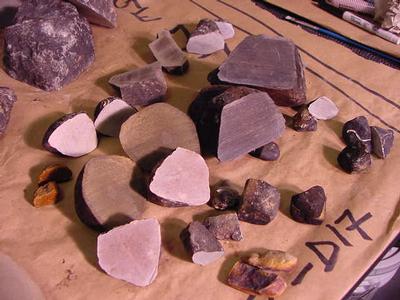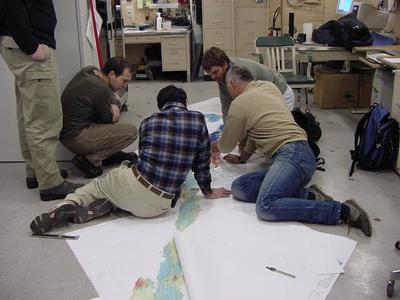16 August, 2001
International Communication
It's another overcast day in the Arctic with temperatures around freezing.
It has been difficult to tell where the ice ends and the sky begins.
We had an interesting dredge last night. It came on deck full of rocks
unlike any others we have seen on our trip. It contained shale, sandstone,
and granite. When the shale was cut in two, it smelled like petroleum!
These first two should be familiar to my 7th grade students, as they are
common West Virginia rocks.
The scientists expected to see a few rocks like these mixed in with the
volcanic ones because glaciers can carry them in. However, to get an entire
load full of them from the area where we dredged was strange. The chief
scientists are intrigued and want to contact other scientists whose
expertise may help form a hypothesis as to where the rocks came from and
when they arrived at Gakkel Ridge.
At this moment several German scientists are visiting from the Polarstern.
They flew over by helicopter and are currently touring our labs and learning
about our equipment. It is important to work closely with these scientists
and communicate with the Polarstern as we are working as a team to achieve
our goals.
I found out today that we might have a little celebration on the ice in a
week or so. The German icebreaker Polarstern, the Swedish icebreaker Oden,
and the USCGC Healy are tentatively planning a rendezvous on the ice. The
talk is of a barbeque and a game of soccer, as well as a tour of each ship.
We are all hoping that this day of "ice liberty" becomes reality!
Statistics:
Latitude: 83 14 N
Longitude 2 34 W
Air temp: 32 F
Water Temp: 30 F

These examples are from the dredge of sedimentary rocks --beautifully colored sandstone and shale. Granite was also in the load. <>

Here the German scientists (far right and far left) discuss future plans with the American scientists. They are sitting on the floor on a giant Seabeam map. <>
Contact the TEA in the field at
.
If you cannot connect through your browser, copy the
TEA's e-mail address in the "To:" line of
your favorite e-mail package.
|
